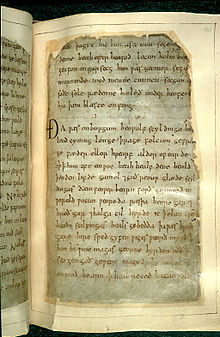Swá ðá maélceare maga Healfdenes
singála séað· ne mihte snotor hæleð
wéan onwendan· wæs þæt gewin tó swýð
láþ ond longsum þe on ðá léode becóm,
nýdwracu níþgrim nihtbealwa maést.
So then over the sorrow of the time the son of Half-Dane
continually brooded; the wise hero could not
turn away woe; that strife was too strong,
hateful and enduring, that on the people came
fearfully cruel, violent trouble, the greatest night-evil.
Beowulf [lines 189-193], from parallel Old English / Modern English text.
 Tolkien dated the poem to the 8th century – and this was Tolkien’s specific area of expertise, as he was a professor of English Philology. Other scholars have thought the poem Beowulf to be younger, but certainly it is at least 1000 years old.
Tolkien dated the poem to the 8th century – and this was Tolkien’s specific area of expertise, as he was a professor of English Philology. Other scholars have thought the poem Beowulf to be younger, but certainly it is at least 1000 years old.
I like the poem because it offers a window into such an ancient, different world, but I like it mostly as a fabulous exemplar of language-change. Presumeably, the first and second texts, above, are the same language, separated only by 1000 years of history. But what makes a language a language? And in that vein, in what way is, for example, the “Korean” of today the same language as the “Korean” used in the Silla Era (pre 900 AD)?
